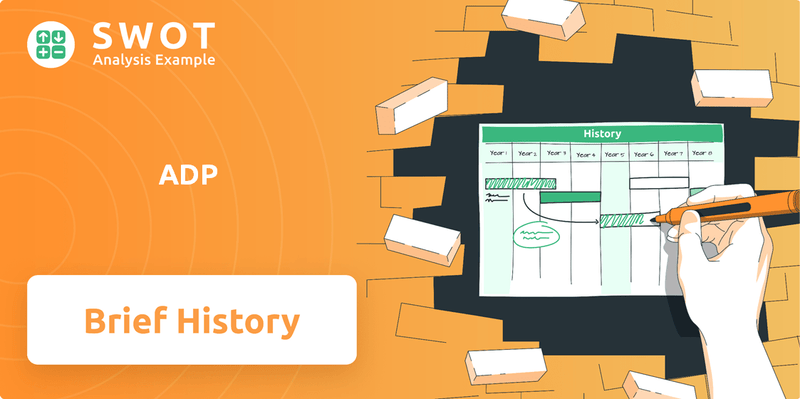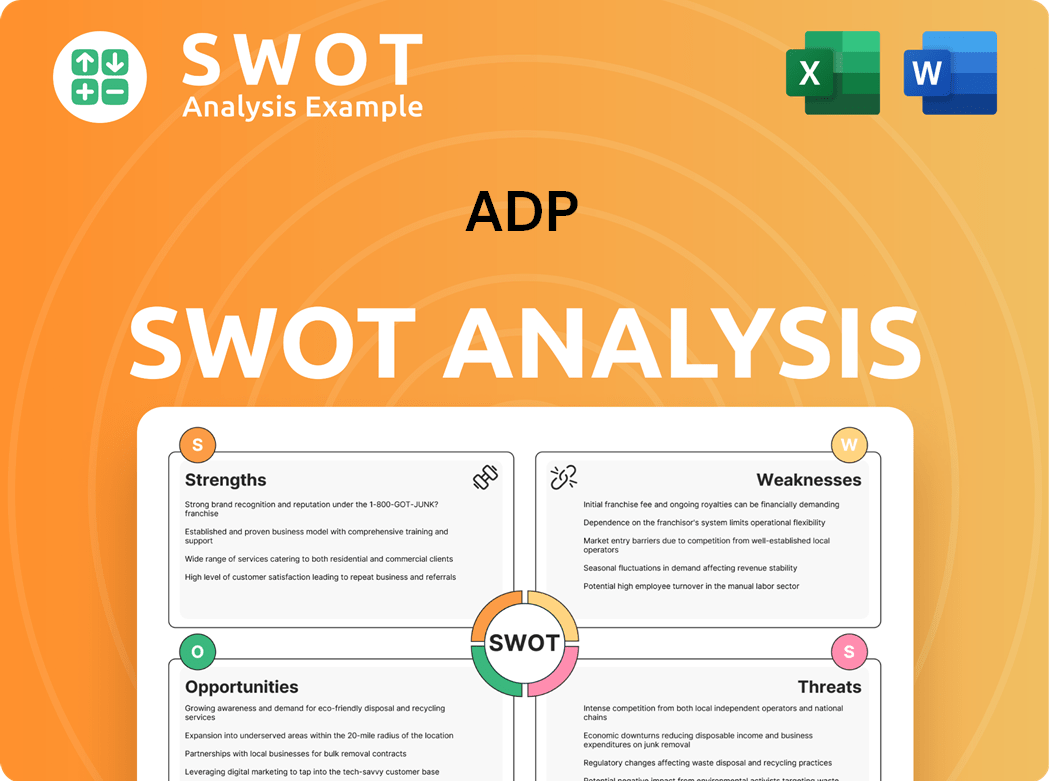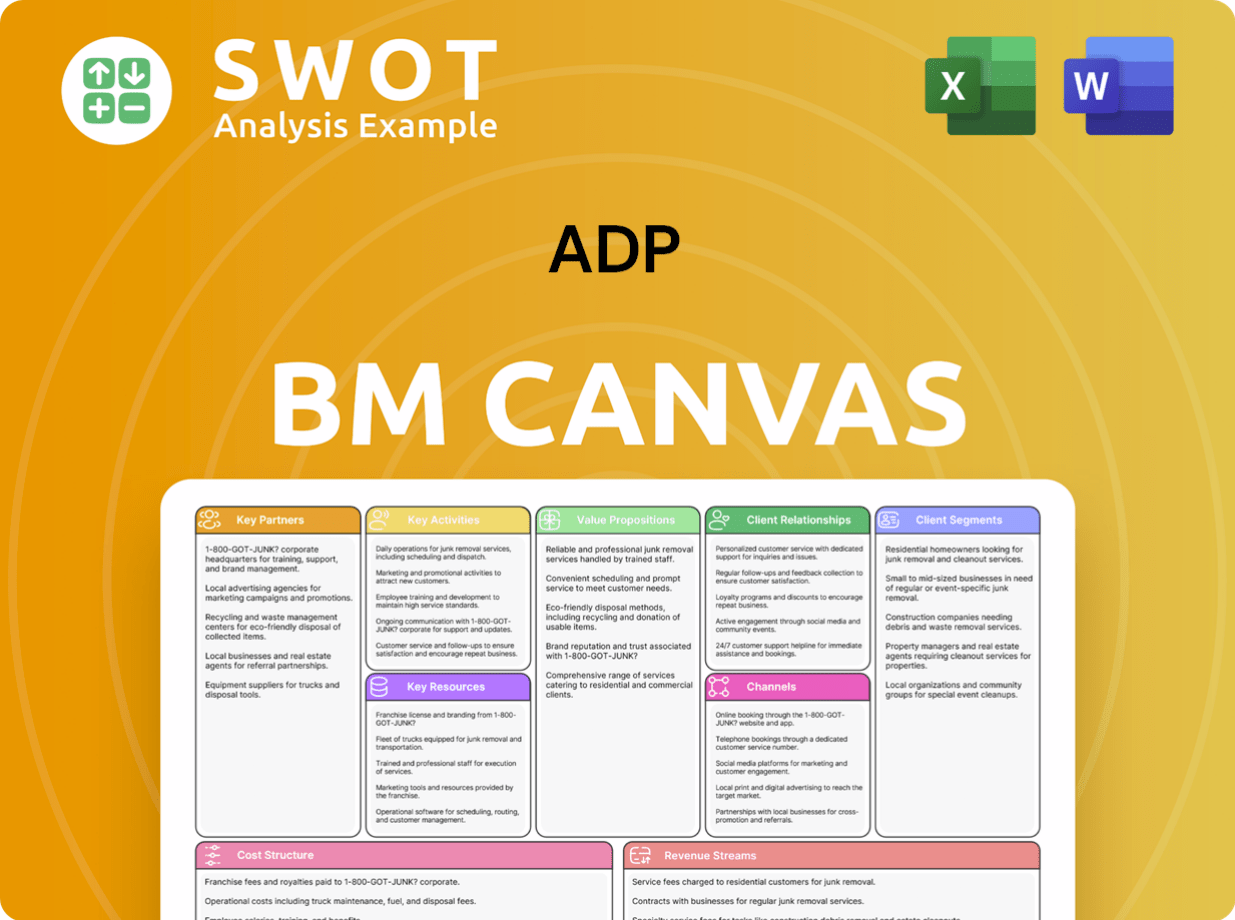ADP Bundle
How did Automatic Data Processing become a global HCM giant?
Imagine a world before automated payroll, where manual calculations and paperwork reigned supreme. This is where the story of ADP, formerly Automatic Payrolls, Inc., begins in 1949. From its humble roots in New Jersey, the ADP SWOT Analysis reveals a fascinating journey of innovation and adaptation. Discover how this company revolutionized payroll processing and beyond.

This brief history of ADP company explores the key milestones that shaped ADP's evolution. Learn about ADP's early services and how it navigated the changing business landscape. Understanding ADP's growth over time provides valuable insights into the company's enduring success and its impact on payroll and the broader HR industry.
What is the ADP Founding Story?
The story of the ADP company began in 1949. It was founded by Henry Taub in Paterson, New Jersey, initially named Automatic Payrolls, Inc. This marked the start of a journey that would transform the payroll and human resources landscape.
Henry Taub was soon joined by his brother Joe Taub, who managed administrative tasks, and Frank Lautenberg, who brought sales and marketing expertise in 1952. The initial capital was modest, with Henry Taub using personal funds and a small loan. The focus was on manual payroll processing for local businesses, addressing the need to streamline a labor-intensive process.
The founders saw an opportunity to improve the payroll process, which was often done manually and prone to errors. Their early efforts laid the groundwork for what would become a major player in the industry. Let's dive into the details of the ADP history and its evolution.
In 1957, Automatic Payrolls, Inc. embraced technology. They moved from manual bookkeeping machines to an IBM computer. This was a significant step towards automation. The company began using punched card machines and check printing machines.
- This shift was crucial for automating data processing.
- In 1961, the company changed its name to Automatic Data Processing, Inc. (ADP).
- This change reflected the company's broader ambitions beyond payroll services.
- ADP went public in 1961 with 300 clients, 125 employees, and revenues of about $400,000.
Frank Lautenberg, who served as president, later became a U.S. Senator from New Jersey in 1982. This highlights the company's impact and the influence of its leaders. The company's early focus on automating payroll processing set the stage for its future growth. To understand more about the market ADP targets, you can read about the Target Market of ADP.
ADP SWOT Analysis
- Complete SWOT Breakdown
- Fully Customizable
- Editable in Excel & Word
- Professional Formatting
- Investor-Ready Format

What Drove the Early Growth of ADP?
Following its initial public offering (IPO) in 1961, the ADP company, formerly known as Automatic Data Processing, began a period of significant expansion. This growth was fueled by a combination of strategic acquisitions and internal development, broadening its service offerings and market reach. The company's evolution reflects a strategic adaptation to the changing needs of businesses, solidifying its position as a key player in the business services sector. Explore the Mission, Vision & Core Values of ADP.
In 1962, ADP opened an office on Wall Street, focusing on payroll and accounting services for brokerage firms. The mid-1960s saw the commencement of a series of acquisitions, including Brokerage Processing Center and Payrolls for Industry of Long Island in 1965. These acquisitions expanded ADP's reach in the brokerage and payroll sectors, laying the foundation for future growth.
The 1970s marked ADP's international expansion, with the establishment of its first international office in the Netherlands in 1973, followed by the United Kingdom in 1977. During this decade, ADP diversified its services, creating divisions like Dealer Services and Claims Services. Key acquisitions such as Time Sharing Limited (TSL) in 1974 and Cyphernetics in 1975 enhanced its online computer services.
The 1980s saw ADP surpass $1 billion in revenues by 1985. Acquisitions, including GTE's Telenet Information Services in 1983, propelled ADP into the stock quote machine business. By the mid-1980s, ADP processed paychecks for approximately 20% of the U.S. workforce. The company's strategic moves continued into the 1990s with the acquisition of Bank of America's payroll business in 1992, adding 17,000 clients.
Through strategic acquisitions and service diversification, ADP solidified its position as a major player in business services. The company's ability to adapt to market changes and expand its offerings has been crucial to its sustained growth. ADP's evolution showcases its commitment to meeting the evolving needs of businesses, particularly in the realm of ADP payroll and related services.
ADP PESTLE Analysis
- Covers All 6 PESTLE Categories
- No Research Needed – Save Hours of Work
- Built by Experts, Trusted by Consultants
- Instant Download, Ready to Use
- 100% Editable, Fully Customizable

What are the key Milestones in ADP history?
The ADP history is marked by many significant milestones that have shaped the human capital management industry. From its early days to its current status, the
| Year | Milestone |
|---|---|
| 1961 | Went public, marking a significant step in its growth and expansion. |
| 1965 | Expanded internationally, entering the UK market. |
| 1973 | Furthered its global reach by entering the Netherlands. |
| 1985 | Exceeded $1 billion in annual revenue, demonstrating substantial financial success. |
| 2006 | Acquired Employease to enhance its SaaS HR solutions. |
| 2014 | Pioneered the HCM Marketplace, expanding its service offerings. |
| 2018 | Acquired WorkMarket to manage freelancers, adapting to changing workforce trends. |
| 2023 | Acquired Sora to bolster workflow automation, improving efficiency. |
| 2024 | Acquired WorkForce Software in October, solidifying its market position. |
| 2025 | Recognized on Fortune Magazine's 'World's Most Admired Companies' list for 19 consecutive years. |
The company has been at the forefront of innovation, particularly in payroll processing.
In the late 1950s,
ADP was a pioneer in payroll automation, streamlining and improving efficiency for businesses. This innovation significantly reduced manual effort and errors in payroll processes.
In 1998, ADP launched EasyPayNet, the first payroll solution in the cloud. This was a major step forward in accessibility and flexibility for
The company pioneered the HCM Marketplace in 2014, offering a platform for various HR solutions. This expanded the company's service offerings and enhanced its value proposition.
ADP was one of the first to launch mobile HCM apps, providing convenient access to HR functions. This enhanced user experience and increased accessibility for clients.
ADP has increasingly integrated data analytics into its services to provide insights and improve decision-making. This helps clients optimize their workforce management strategies.
Despite its successes, the company has faced challenges, including adapting to market changes and integrating acquisitions. Navigating these challenges has required strategic adjustments and a focus on client satisfaction.
The growing PC industry in the 1980s presented a challenge, as companies could perform some services in-house. ADP adapted by enhancing its offerings and focusing on value-added services.
Integrating different cultures, services, and systems from numerous acquisitions has been a complex challenge. ADP has continually worked to streamline these integrations for better efficiency.
Market downturns and competitive pressures are ongoing challenges in the dynamic HCM landscape. ADP has addressed these challenges through innovation, strategic acquisitions, and adapting its business model.
Keeping pace with rapid technological advancements requires continuous investment and adaptation. ADP has consistently embraced new technologies to remain competitive.
Ensuring data security and privacy is a critical challenge in the digital age. ADP has invested heavily in cybersecurity measures to protect client data.
Adapting to evolving workforce dynamics, including remote work and the gig economy, is essential. ADP has expanded its services to meet these changing needs.
ADP Business Model Canvas
- Complete 9-Block Business Model Canvas
- Effortlessly Communicate Your Business Strategy
- Investor-Ready BMC Format
- 100% Editable and Customizable
- Clear and Structured Layout

What is the Timeline of Key Events for ADP?
The evolution of Automatic Data Processing (ADP), a leading provider of human capital management solutions, is marked by significant milestones. From its humble beginnings in 1949 as Automatic Payrolls, Inc., founded by Henry Taub, the company has grown into a global leader. A pivotal moment came in 1957 when it adopted an IBM computer and was renamed Automatic Data Processing, Inc. (ADP). The company went public in 1961, and by 1985, its annual revenues exceeded $1 billion. Further expansion included the launch of EasyPayNet in 1998, the first cloud-based payroll solution, and the spin-off of its Brokerage Service Group in 2007 to form Broadridge Financial Solutions. Recent acquisitions, such as WorkMarket and Celergo in 2018, Sora in 2023, and WorkForce Software in 2024, highlight its commitment to growth. In 2024, ADP celebrated 75 years of innovation.
| Year | Key Event |
|---|---|
| 1949 | Henry Taub founded Automatic Payrolls, Inc. |
| 1957 | The company switched to using an IBM computer and was renamed Automatic Data Processing, Inc. (ADP). |
| 1961 | ADP went public. |
| 1965 | Established its first international subsidiary in the UK. |
| 1973 | Launched ADP International in the Netherlands. |
| 1985 | Annual revenues exceeded $1 billion. |
| 1992 | Acquired Bank of America's payroll services. |
| 1998 | Launched EasyPayNet, the first cloud-based payroll solution. |
| 2007 | Spun off Brokerage Service Group to form Broadridge Financial Solutions. |
| 2014 | Launched ADP Marketplace, the first HCM marketplace. |
| 2018 | Acquired WorkMarket and Celergo. |
| 2023 | Acquired Sora. |
| 2024 | Celebrated 75 years of innovation and acquired WorkForce Software. |
| 2025 | Reported strong Q1 results with 12.2% revenue increase and confirms 2025 targets. Hosts Investor Day on June 12, 2025. |
ADP is focusing on leveraging generative AI to drive growth and enhance productivity. This technology is expected to improve operational efficiency and user experience across its services. The company is investing in AI to streamline processes and offer more advanced solutions to its clients.
The company is committed to its digital transformation journey to modernize internal processes and improve user experience. This includes updating its technology infrastructure and enhancing its digital offerings. This transformation aims to make ADP services more efficient and user-friendly.
Strategic initiatives include continued investment in its business for sustainable, long-term growth and expanding its global service and scale. ADP is focusing on expanding its global presence to serve a wider range of clients. This includes further acquisitions and partnerships.
For fiscal year 2025, ADP anticipates revenue growth of 6% to 7%, with adjusted EBIT margin expansion of 40 to 50 basis points. The company expects adjusted diluted EPS growth of 8% to 9% and client funds balances growth of 5% to 6%. ADP's focus remains on long-term value creation and sustainable growth.
ADP Porter's Five Forces Analysis
- Covers All 5 Competitive Forces in Detail
- Structured for Consultants, Students, and Founders
- 100% Editable in Microsoft Word & Excel
- Instant Digital Download – Use Immediately
- Compatible with Mac & PC – Fully Unlocked

Related Blogs
- What is Competitive Landscape of ADP Company?
- What is Growth Strategy and Future Prospects of ADP Company?
- How Does ADP Company Work?
- What is Sales and Marketing Strategy of ADP Company?
- What is Brief History of ADP Company?
- Who Owns ADP Company?
- What is Customer Demographics and Target Market of ADP Company?
Disclaimer
All information, articles, and product details provided on this website are for general informational and educational purposes only. We do not claim any ownership over, nor do we intend to infringe upon, any trademarks, copyrights, logos, brand names, or other intellectual property mentioned or depicted on this site. Such intellectual property remains the property of its respective owners, and any references here are made solely for identification or informational purposes, without implying any affiliation, endorsement, or partnership.
We make no representations or warranties, express or implied, regarding the accuracy, completeness, or suitability of any content or products presented. Nothing on this website should be construed as legal, tax, investment, financial, medical, or other professional advice. In addition, no part of this site—including articles or product references—constitutes a solicitation, recommendation, endorsement, advertisement, or offer to buy or sell any securities, franchises, or other financial instruments, particularly in jurisdictions where such activity would be unlawful.
All content is of a general nature and may not address the specific circumstances of any individual or entity. It is not a substitute for professional advice or services. Any actions you take based on the information provided here are strictly at your own risk. You accept full responsibility for any decisions or outcomes arising from your use of this website and agree to release us from any liability in connection with your use of, or reliance upon, the content or products found herein.